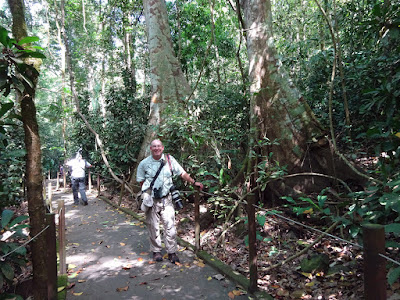We arranged for a
private guide (Armando) to take us to the Carara National Park. Armando is a delightful young man that knows
his forest birds!
Carara National Park
is a 4700 hectare protected area. The
elevations range from 328 to 1640 feet.
It is regenerating tropical lowland rainforest and tropical dry
forest. Carara is the Huetar Indian word
for crocodile.
As soon as we get out of the car Armando is spotting birds!
As soon as we get out of the car Armando is spotting birds!
Rufous-naped Wren
We enjoyed seeing a Turquoise-browed Motmot perched on a wire in the parking area. This is a species of Motmot that we've not seen previously in our Central American Trips.
Turquoise-browed Motmot
Also spotted in the parking area was this Ctenosaur (aka Black Iguana) that had taken up residence in the drain pipe of an old building slab. We didn't think it was real at first!
Ctenosaur
The trails are well
maintained which makes it easy to look for birds and walk at the same time!
Trail
intersections were marked by these cute carvings.
We saw plenty of birds
on our 6 hour trip but the Scarlet Macaw was our favorite.
Scarlet Macaw mated pair
We saw many different birds tucked away in the deepest, darkest parts of the forest. They were tough to see, but Mark did a great job
getting bird pictures in the dark undergrowth! This little Streak-chested Antpitta is no bigger than a can of soda, and stayed on the forest floor. But his constant singing gave him away!
Streak-chested Antpitta
Another species in the antbird family was this Chestnut-backed Antbird. It was a little more cooperative.
Chestnut-backed Antbird
One group of tropical rainforest birds that we look forward to seeing are the trogans. On this walk we got great looks at both a male and female Black-throated Trogan. As is always the case with trogans, the male is more colorful than the female.
Black-throated Trogan male
Black-throated Trogan female
Other rainforest species on our walk were woodcreepers and puffbirds.
Streak-headed Woodcreeper
White-whiskered Puffbird
Armando mentioned that
he has some other birding places and even some “secret” hotspots that only he
knows about. We make arrangements for
him to take us out again the next morning.
We head in for lunch
and relax the rest of the day.
Next time: Day 6: Mangroves and more great birding!
Birds seen at Carara
National Park:
Great Tinamou
Bare-throated Tiger
Heron
Black Vulture
Turkey Vulture
Osprey
Short-billed Pigeon
Ruddy Ground-Dove
White-tipped Dove
Gray-chested Dove
Squirrel Cuckoo
Band-tailed Barbthroat
Long-billed Hermit
Stripe-throated Hermit
Scaly-breasted
Hummingbird
Crowned Woodnymph
Steely-vented
Hummingbird
Blue-throated
Goldentail
Gartered Trogon
Black-throated Trogon
Lesson’s Motmot
Turquoise-browed
Motmot
Rufous-tailed Jacamar
Yellow-throated Toucan
Pale-billed Woodpecker
Brown-hooded Parrot
(heard)
Scarlet Macaw
Black-hooded Antshrike
Slaty Antwren
Dot-winged Antwren
Chestnut-backed
Antbird
Streak-chested
Antpitta
Wedge-billed
Woodcreeper
Cocoa Woodcreeper
Plain Xenops
Yellow-bellied
Tyrannulet
Greenish Elaenia
Northern Bentbill
(heard)
Slate-headed
Tody-Flycatcher
Eye-ringed Flatbill
Yellow-olive
Flycatcher
Stub-tailed Spadebill
Golden-crowned
Spadebill
Sulphur-rumped
Flycatcher
Dusky-capped
Flycatcher
Boat-billed Flycatcher
Streaked Flycatcher
Rufous piha
Blue-crowned Manakin
Red-capped Manakin
Rose-throated Becard
Tawny-crowned Greenlet
Lesser Greenlet
Rufous-napped Wren
Riverside Wren
Tropical Gnatcatcher
Black and White
Warbler
Tennessee Warbler
Kentucky Warbler
Yellow Warbler
Chestnut-sided Warbler
Buff-rumped Warbler
White-shouldered
Tanager
Red-legged
Honeycreeper
Orange-billed Sparrow
Summer Tanager
Baltimore Oriole
Mantled Howler Monkey
Central American
Aguoti
Black Iguana
















That is quite a list. People are excited about Trogans here too.
ReplyDeleteThis is fun, touring through blog.
ReplyDeleteVirginia